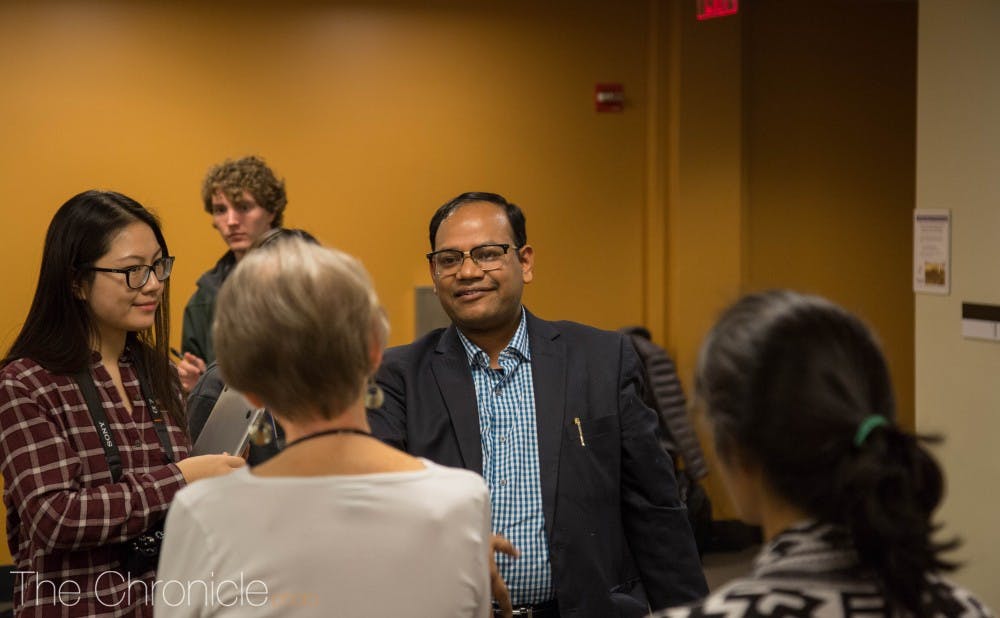A major human rights issue worlds away was flung into the foreground at a film screening and discussion Tuesday.
Junior James Wang and senior Bochen Han—president and former president of the Duke East Asia Nexus Corps, respectively—hosted the screening of the 2017 documentary "Sittwe: Youth Dialogue on the Buddhist-Muslim Conflict." Burmese producer Myo Win discussed the complex and frequently bloody relationship between the Buddhist majority and subjugated Muslim Rohingya population of the southeast Asian country, Myanmar.
Sittwe is centered around the perspectives of Phyu Phyu Than, a Rohingya girl, and Aung San Myint, a Buddhist boy. Although they both live within miles of each other in the Burmese state of Rakhine, the barbed wire fence that marks the border of Than’s internment camp results in mirrored perspectives of two sides that continue to face off in this divided nation.
“We don’t want to live together with them, because conflict could happen again,” Myint said in one interview session that was showcased in the screening. “They have the idea to take over and make this their own country.”
In the talk following the screening, Win said that though many of Myint’s ideas about the danger the Rohingya pose are largely unfounded, views like his have resulted in the exodus of over 600,000 Burmese Muslims since the start of violence in 2012, along with countless untold murders, rapes and massacres. Falsely alleged by Buddhist nationalists to be Bangladeshi foreigners, the Rohingya have been stripped of numerous rights, including the right to citizenship and even formal status as a Burmese minority group, Win noted.
He added that the Rohingya do not have access to fundamental needs like healthcare or education and that they require a permit to do basic things like marry or travel between cities—some of which they cannot enter at all.
“[This is] a Hitler strategy of force information, every day,” Win said. “They are showing their public, ‘enemy of the people.'”
In Buddhist communities living as close to the Rohingya as the one documented in this film, meanwhile, the young people Win’s team interviewed often seemed conflicted on how to view those living on the other side of the fence.
“We played together,” Buddhist Hla Win Htun said of a Rohingya childhood friend in the documentary. “I’d like to see her again—but I think we can’t be friends like before.”
Even as she said this, Htun looked visibly uncomfortable—brushing distractedly at her face and hair.
Given the long and complicated history of Buddhist-Muslim conflicts in Myanmar, such discomfort is hardly surprising. Win explained that the roots of this conflict go back to the coup of 1962. Since then, the largely military-controlled Burmese government has supported a number of fictional accounts of the history of the Rohingya.
"We must preserve the Rakhine race!” one man in the footage shouted. “People from Bangladesh should be called Bengali!”
Despite the volume and vehemence with which many Burmese repeat these claims, however, Win said that they are entirely unsubstantiated. The Rohingya had, in fact, been living in relative peace in Myanmar for centuries before the military coup; they are not Bangladeshi, and they have never been Bangladeshi. He added that while the Burmese government does not directly contribute to these rumors, it does not attempt to correct them and in fact uses them to partly justify its internment of the Rohingya.
“Every day, they are living with fear and torture,” Win said.
One of Sittwe’s most striking features, in fact, was the way it chronicled the continued violence between Burmese Buddhists and Muslims since the outbreak of the conflict. Buddhist anti-Muslim protests incited an assault by self-described ‘Rohingya militants’ on Buddhist police officers and border guards. The Burmese army launched a massive counterattack in response—leaving wide swaths of destruction in its wake.
“They entered each house and destroyed everyone inside,” one anonymous 16-year-old Rohingya girl said. “Two of them held my mother down while they raped me.”
Both Sittwe and Win confirmed that mass killings and sexual assaults have been a prominent feature of many Burmese military maneuvers. Some Burmese Buddhists, however, tell a very different story of who is responsible for the violence.
“They came into our community to destroy,” Myint said. “As Buddhists, we would not destroy anything. But they destroyed their own houses.”
One thing both sides agreed on in this documentary, though, was that the violence needed to end.
“You are a human being and I am a human being. Why are we living so differently?” Phyu asked.
Get The Chronicle straight to your inbox
Sign up for our weekly newsletter. Cancel at any time.
Myint expressed a similar sentiment.
“Everyone is tired of the conflict. Our country is struggling,” she said.
That craving for peace and perhaps ultimate understanding across sides was a common element in many interviewees’ responses in Sittwe. Even after the evening was over, the event's attendees one by one filing out wrapped up in their own thoughts, that core desire for human connection seemed to have made its mark on the crowd.
First-year William Chang stressed the importance of understanding different perspectives when asked about his views on the talk.
“Why they make these choice[s], it’s very different from us,” he said of the groups discussed that evening. “It’s why I want to attend events like this, why I think more student organization should host events like this."

